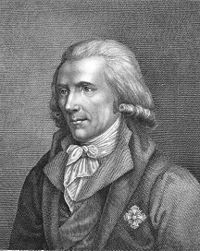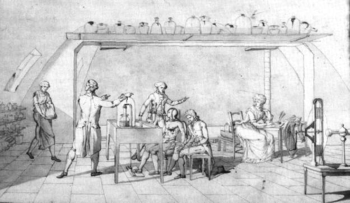
Marie-Anne Pierrette Paulze
Encyclopedia

Montbrison, Loire
Montbrison is a commune in the Loire department in central France.The commune gives its name to the popular blue cheese Fourme de Montbrison which has been made in the region for centuries.-History:...
, in a small province in France
France
The French Republic , The French Republic , The French Republic , (commonly known as France , is a unitary semi-presidential republic in Western Europe with several overseas territories and islands located on other continents and in the Indian, Pacific, and Atlantic oceans. Metropolitan France...
. She is most commonly known as the spouse of Antoine Lavoisier
Antoine Lavoisier
Antoine-Laurent de Lavoisier , the "father of modern chemistry", was a French nobleman prominent in the histories of chemistry and biology...
(Madame Lavoisier) but many do not know of her accomplishments in the field of chemistry
Chemistry
Chemistry is the science of matter, especially its chemical reactions, but also its composition, structure and properties. Chemistry is concerned with atoms and their interactions with other atoms, and particularly with the properties of chemical bonds....
: she acted as the laboratory assistant of her spouse and contributed to his work.
Background
Her father, Jacques Paulze, was of French descent and worked primarily as a parliamentary lawyer and financier. Most of his income came from running the Ferme GénéraleFerme générale
The Ferme générale was, in ancien régime France, essentially an outsourced customs and excise operation which collected duties on behalf of the king, under six-year contracts...
(The General Farm) which was a private consortium
Consortium
A consortium is an association of two or more individuals, companies, organizations or governments with the objective of participating in a common activity or pooling their resources for achieving a common goal....
of financiers who paid the French monarchy for the privilege of collecting certain taxes. Her mother, Claudine Thoynet Paulze, died in 1761, leaving behind not only Marie-Anne but two other sons. After her mother’s death Marie-Anne was placed in a convent
Convent
A convent is either a community of priests, religious brothers, religious sisters, or nuns, or the building used by the community, particularly in the Roman Catholic Church and in the Anglican Communion...
where she received her formal education.
At the age of thirteen Marie-Anne received a marriage proposal from the Count d’Amerval, who was nearly three times her age. Jacques Paulze tried to object to the union, but received threats about losing his job with the Ferme Générale. To indirectly thwart the marriage, Jacque Paulze made an offer to one of his colleagues to ask for his daughter’s hand instead. This colleague was Antoine Lavoisier
Antoine Lavoisier
Antoine-Laurent de Lavoisier , the "father of modern chemistry", was a French nobleman prominent in the histories of chemistry and biology...
, a French nobleman and scientist
Scientist
A scientist in a broad sense is one engaging in a systematic activity to acquire knowledge. In a more restricted sense, a scientist is an individual who uses the scientific method. The person may be an expert in one or more areas of science. This article focuses on the more restricted use of the word...
. Lavoisier accepted the proposition, and he and Marie-Anne were married on 16 December 1771. Lavoisier was about 28.
Lavoisier continued to work for the Ferme-Générale but in 1775 was appointed gunpowder
Gunpowder
Gunpowder, also known since in the late 19th century as black powder, was the first chemical explosive and the only one known until the mid 1800s. It is a mixture of sulfur, charcoal, and potassium nitrate - with the sulfur and charcoal acting as fuels, while the saltpeter works as an oxidizer...
administrator, leading the couple to settle down at the Arsenal in Paris. Here, Lavoisier’s interest in chemistry blossomed, and, with the financial security provided by both his and Marie-Anne’s family, as well as his various titles and other business ventures, he was able to construct a state-of-the-art chemistry laboratory. Marie-Anne soon became interested in his scientific research and began to actively participate in his laboratory work.
As her interest developed, she received formal training in the field from Jean-Baptiste Bucquet and Philippe Gingembre, both of whom were Lavoisier’s colleagues at the time. The Lavoisiers spent most of their time together in the laboratory, working as a team conducting research on many fronts. In fact, the majority of the research effort put forth in the laboratory was actually a joint effort between Marie-Anne and her husband, with Marie-Anne mainly playing the role of laboratory assistant.
French Revolution
In 1794 Lavoisier, due to his prominent position in the Ferme-Générale, was branded a traitor during the Reign of TerrorReign of Terror
The Reign of Terror , also known simply as The Terror , was a period of violence that occurred after the onset of the French Revolution, incited by conflict between rival political factions, the Girondins and the Jacobins, and marked by mass executions of "enemies of...
by French revolutionaries. Marie-Anne’s father, another prominent Ferme-Générale member, was arrested on similar grounds. On 28 November 1793 Lavoisier surrendered to revolutionaries and was imprisoned at Port-Libre. Throughout his imprisonment Marie-Anne visited Lavoisier regularly and fought for his release. She presented his case before Antoine Dupin, who was Lavoisier’s accuser and a former member of the Ferme-Générale. She told of her husband’s accomplishments as a scientist and his importance to the nation of France. Despite her efforts Lavoisier was tried, convicted of treason and executed on 8 May 1794 in Paris, at the age of 50. Jacques Paulze, Marie-Anne’s father, was also executed on the same day.
After his death Marie-Anne became bitter about what had happened to her husband. She was thrown into bankruptcy following the new government's confiscation of her money and property. In addition, the new government seized all of Lavoisier’s notebooks and laboratory equipment. Despite these obstacles, Marie-Anne organized the publication of Lavoisier’s final memoirs, Mémoires de Chimie, a compilation of his papers and those of his colleagues demonstrating the principles of the new chemistry. The first volume contained work on heat and the formation of liquids, while the second dealt with the ideas of combustion, air, calcination
Calcination
Calcination is a thermal treatment process applied to ores and other solid materials to bring about a thermal decomposition, phase transition, or removal of a volatile fraction. The calcination process normally takes place at temperatures below the melting point of the product materials...
of metals, action of acids, and the composition of water. In the original copy Marie-Anne wrote the preface and attacked revolutionaries and Lavoisier’s contemporaries, whom she believed to be responsible for his death. This preface, however, was not included in the final publication. Nevertheless, her efforts secured her husband's legacy in the field of chemistry.
Benjamin Thompson

Benjamin Thompson
Sir Benjamin Thompson, Count Rumford , FRS was an American-born British physicist and inventor whose challenges to established physical theory were part of the 19th century revolution in thermodynamics. He also served as a Lieutenant-Colonel in the Loyalist forces in America during the American...
(Count Rumford). Rumford was one of the most well-known physicists at the time, but the marriage between the two was difficult and short-lived. Marie-Anne also insisted throughout her life that she retain the last name of her first husband, demonstrating her undying devotion to him. Marie-Anne died suddenly in her home in Paris on 10 February 1836, at the age of 78.
Contributions to chemistry

Jacques-Louis David
Jacques-Louis David was an influential French painter in the Neoclassical style, considered to be the preeminent painter of the era...
allowed her to accurately and precisely draw experimental apparatuses, which ultimately helped many of Lavoisier’s contemporaries to understand his methods and results. Furthermore, she served as the editor of his reports. Together, the Lavoisiers rebuilt the field of chemistry, which had its roots in alchemy and at the time was a convoluted science dominated by George Stahl’s theory of phlogiston.
In the eighteenth century the idea of phlogiston (a fire-like element which is gained or released during a material’s combustion) was used to describe the apparent property changes that substances exhibited when burned. Marie-Anne, being a master in the English, Latin, and French languages, was able to translate various works about phlogiston into French for her husband to read. Perhaps her most important translation was that of Richard Kirwan
Richard Kirwan
Richard Kirwan FRS was an Irish scientist. He is remembered today, if at all, for being one of the last supporters of the theory of phlogiston. Kirwan was active in the fields of chemistry, meteorology, and geology...
's essay 'Essay on Phlogiston and the Constitution of Acids' (see google books), which she both translated and critiqued, adding footnotes as she went along and pointing out errors in the chemistry made throughout the paper. She also translated works by Joseph Priestley
Joseph Priestley
Joseph Priestley, FRS was an 18th-century English theologian, Dissenting clergyman, natural philosopher, chemist, educator, and political theorist who published over 150 works...
, Henry Cavendish
Henry Cavendish
Henry Cavendish FRS was a British scientist noted for his discovery of hydrogen or what he called "inflammable air". He described the density of inflammable air, which formed water on combustion, in a 1766 paper "On Factitious Airs". Antoine Lavoisier later reproduced Cavendish's experiment and...
, and others for Lavoisier’s personal use. This was an invaluable service to Lavoisier, who relied on Marie-Anne’s translation of foreign works to keep abreast of current developments in chemistry. In the case of phlogiston, it was Marie-Anne’s translation that convinced him the idea was incorrect, ultimately leading to his studies of combustion and his discovery of oxygen gas.
Marie-Anne was also instrumental in the 1789 publication of Lavoisier’s Elementary Treatise on Chemistry, which presented a unified view of chemistry as a field. This work proved pivotal in the progression of chemistry, as it presented the idea of conservation of mass as well as a list of elements and a new system for chemical nomenclature. Marie-Anne contributed thirteen drawings that showed all the laboratory instrumentation and equipment used by the Lavoisiers in their experiments. She also kept strict records of the procedures followed, lending validity to the findings Lavoisier published.
Accomplishments as a historian
Before her death, Marie-Anne was able to recover nearly all of Lavoisier’s notebooks and chemical apparatuses, most of which survive in a collection at Cornell UniversityCornell University
Cornell University is an Ivy League university located in Ithaca, New York, United States. It is a private land-grant university, receiving annual funding from the State of New York for certain educational missions...
, the largest of its kind outside of Europe.
External links
The transcript page includes Marie Lavoisier's engraving of a gazometer, from Traité Élémentaire de ChimieTraité Élémentaire de Chimie
Traité élémentaire de chimie is an influential textbook written by Antoine Lavoisier published in 1789 and translated into English by Robert Kerr in 1790.The book is considered to be the first modern chemical textbook...
.

